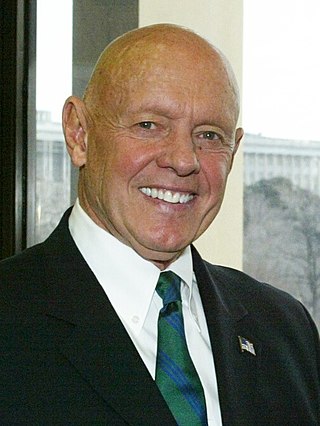Related Research Articles

Amway Corp. is an American multi-level marketing (MLM) company that sells health, beauty, and home care products. The company was founded in 1959 by Jay Van Andel and Richard DeVos and is based in Ada, Michigan. Amway and its sister companies under Alticor reported sales of $8.9 billion in 2019. It is the largest multi-level marketing company in the world by revenue. It conducts business through a number of affiliated companies in more than a hundred countries and territories.

Public relations (PR) is the practice of managing and disseminating information from an individual or an organization to the public in order to influence their perception. Public relations and publicity differ in that PR is controlled internally, whereas publicity is not controlled and contributed by external parties. Public relations may include an organization or individual gaining exposure to their audiences using topics of public interest and news items that do not require direct payment. The exposure is mostly media-based, and this differentiates it from advertising as a form of marketing communications. Public relations aims to create or obtain coverage for clients for free, also known as earned media, rather than paying for marketing or advertising also known as paid media. But in the early 21st century, advertising is also a part of broader PR activities.
Christian fundamentalism, also known as fundamental Christianity or fundamentalist Christianity, is a religious movement emphasizing biblical literalism. In its modern form, it began in the late 19th and early 20th centuries among British and American Protestants as a reaction to theological liberalism and cultural modernism. Fundamentalists argued that 19th-century modernist theologians had misunderstood or rejected certain doctrines, especially biblical inerrancy, which they considered the fundamentals of the Christian faith.

Proselytism is the policy of attempting to convert people's religious or political beliefs. Carrying out attempts to instill beliefs can be called proselytization.

Stephen Richards Covey was an American educator, author, businessman, and speaker. His most popular book is The 7 Habits of Highly Effective People. His other books include First Things First, Principle-Centered Leadership, The 7 Habits of Highly Effective Families, The 8th Habit, and The Leader In Me: How Schools and Parents Around the World Are Inspiring Greatness, One Child at a Time. In 1996, Time magazine named him one of the 25 most influential people. He was a professor at the Jon M. Huntsman School of Business at Utah State University (USU) at the time of his death.
Marketing management is the strategic organizational discipline which focuses on the practical application of marketing orientation, techniques and methods inside enterprises and organizations and on the management of marketing resources and activities. Compare marketology, which Aghazadeh defines in terms of "recognizing, generating and disseminating market insight to ensure better market-related decisions".

Charles Frazier Stanley Jr. was an American Southern Baptist pastor and writer. He was senior pastor of First Baptist Church in Atlanta for 49 years and took on emeritus status in 2020. He founded and was president of In Touch Ministries which widely broadcasts his sermons through television and radio. He also served two one-year terms as president of the Southern Baptist Convention, from 1984 to 1986.
Prosperity theology is a religious belief among some Charismatic Christians that financial blessing and physical well-being are always the will of God for them, and that faith, positive speech, and donations to religious causes will increase one's material wealth. Material and especially financial success is seen as a sign of divine favor.

Playtex is an American brand name for undergarments, baby products, gloves, feminine hygiene products, and sunscreen. The brand began in 1947 when International Latex Corporation (ILC) created a division named Playtex to produce and sell latex products. Playtex was the first to advertise undergarments on national television in 1955, written by Howard Shavelson at Ogilvy and Mather, and the first to show a woman wearing only a bra from the waist up in a commercial in 1977. They developed space suits for the Apollo program.
A doomsday cult is a cult that believes in apocalypticism and millenarianism, including both those that predict disaster and those that attempt to destroy the entire universe. Sociologist John Lofland coined the term doomsday cult in his 1966 study of a group of members belonging to the Unification Church of the United States: Doomsday Cult: A Study of Conversion, Proselytization, and Maintenance of Faith. In 1958, Leon Festinger published a study of a group with cataclysmic predictions: When Prophecy Fails: A Social and Psychological Study of a Modern Group that Predicted the Destruction of the World.

Timothy James Keller was an American Calvinist pastor, preacher, theologian, and Christian apologist. He was the chairman and co-founder of Redeemer City to City, which trains pastors for service around the world. He was also the founding pastor of Redeemer Presbyterian Church in New York City and the author of The New York Times bestselling books The Prodigal God: Recovering the Heart of the Christian Faith (2008), Prayer: Experiencing Awe and Intimacy with God (2014), and The Reason for God: Belief in an Age of Skepticism (2008). The prequel for the latter is Making Sense of GOD: An Invitation to the Skeptical (2016).

Influencer marketing is a form of social media marketing involving endorsements and product placement from influencers, people and organizations who have a purported expert level of knowledge or social influence in their field. Influencers are someone with the power to affect the buying habits or quantifiable actions of others by uploading some form of original—often sponsored—content to social media platforms like Instagram, YouTube, Snapchat, TikTok or other online channels. Influencer marketing is when a brand enrolls influencers who have an established credibility and audience on social media platforms to discuss or mention the brand in a social media post. Influencer content may be framed as testimonial advertising.

A brand ambassador is a person engaged by an organization or company to represent its brand in a positive light, helping to increase brand awareness and sales. The brand ambassador is meant to embody the corporate identity in appearance, demeanor, values and ethics. The key element of brand ambassadors is their ability to use promotional strategies that will strengthen the customer-product-service relationship, influence a large audience to buy and consume more.
Customer engagement is an interaction between an external consumer/customer and an organization through various online or offline channels. According to Hollebeek, Srivastava and Chen S-D logic-Definition of customer engagement is "a customer’s motivationally driven, volitional investment of operant resources, and operand resources into brand interactions," which applies to online and offline engagement.

Content marketing is a form of marketing focused on creating, publishing, and distributing content for a targeted audience online. It is often used in order to achieve the following business goals: attract attention and generate leads, expand their customer base, generate or increase online sales, increase brand awareness or credibility, and engage an online community of users. Content marketing attracts new customers by creating and sharing valuable free content as well as by helping companies create sustainable brand loyalty, providing valuable information to consumers, and creating a willingness to purchase products from the company in the future.

A brand is a name, term, design, symbol or any other feature that distinguishes one seller's good or service from those of other sellers. Brands are used in business, marketing, and advertising for recognition and, importantly, to create and store value as brand equity for the object identified, to the benefit of the brand's customers, its owners and shareholders. Brand names are sometimes distinguished from generic or store brands.
This bibliography of Barack Obama is a list of written and published works, both books and films, about Barack Obama, the 44th president of the United States.
Word-of-mouth marketing is the communication between consumers about a product, service, or company in which the sources are considered independent of direct commercial influence that has been actively influenced or encouraged as a marketing effort. While it is difficult to truly control word of mouth communication, there are three generic avenues to 'manage' word of mouth communication for the purpose of word-of-mouth marketing, including:
A social employee is a worker operating within a social business model. Following an organization's social computing guidelines, social employees use social media tools both for internal workflow and collaboration purposes and for external engagement with customers, prospects and stakeholders through a combination of social media marketing, content marketing, social marketing, and social selling. Social employee programs are considered to be as much about culture and engagement as they are about business processes and best practices. In addition to increased leads and sales, social employee best practices are said to improve business outcomes important to social media marketing, such as increased connections and web traffic, improved brand identification and "chatter", and better customer advocacy.

American singer-songwriter and actress Madonna has incorporated in her works references of religious themes of different religions and spiritual practices, including Christianity, Judaism, Hinduism, Buddhism, Sufism, and Kabbalah. It became one of the most defining and controversial aspects of her career, with responses documented in the sector, popular press and from diverse theologians, sociologists of religion and other scholars of religion to different degrees and perspectives.
References
- 1 2 Mara Einstein. "The Evolution of Religious Branding", Social Compass, Volume 58 Issue 3, September 2011.
- ↑ Flynn, John (July 26, 2009). "Churches Communicating a Message of Hope". Global Zenit News. Archived from the original on April 16, 2013.
- ↑ Jacobs, Mary (April 14, 2007). "Don't shy from marketing savvy in branding faith". The United Methodist Reporter. Archived from the original on 2007-05-18.